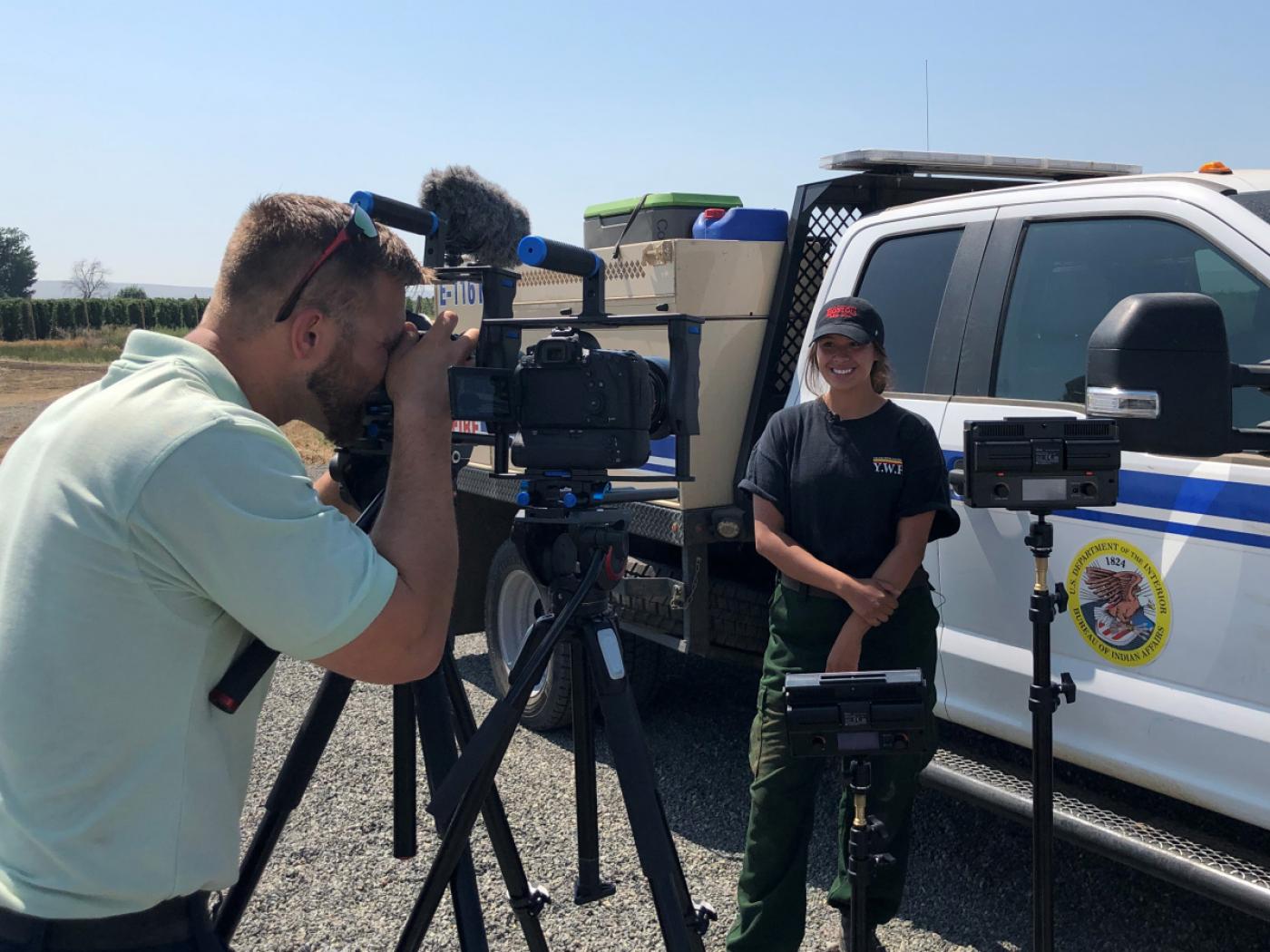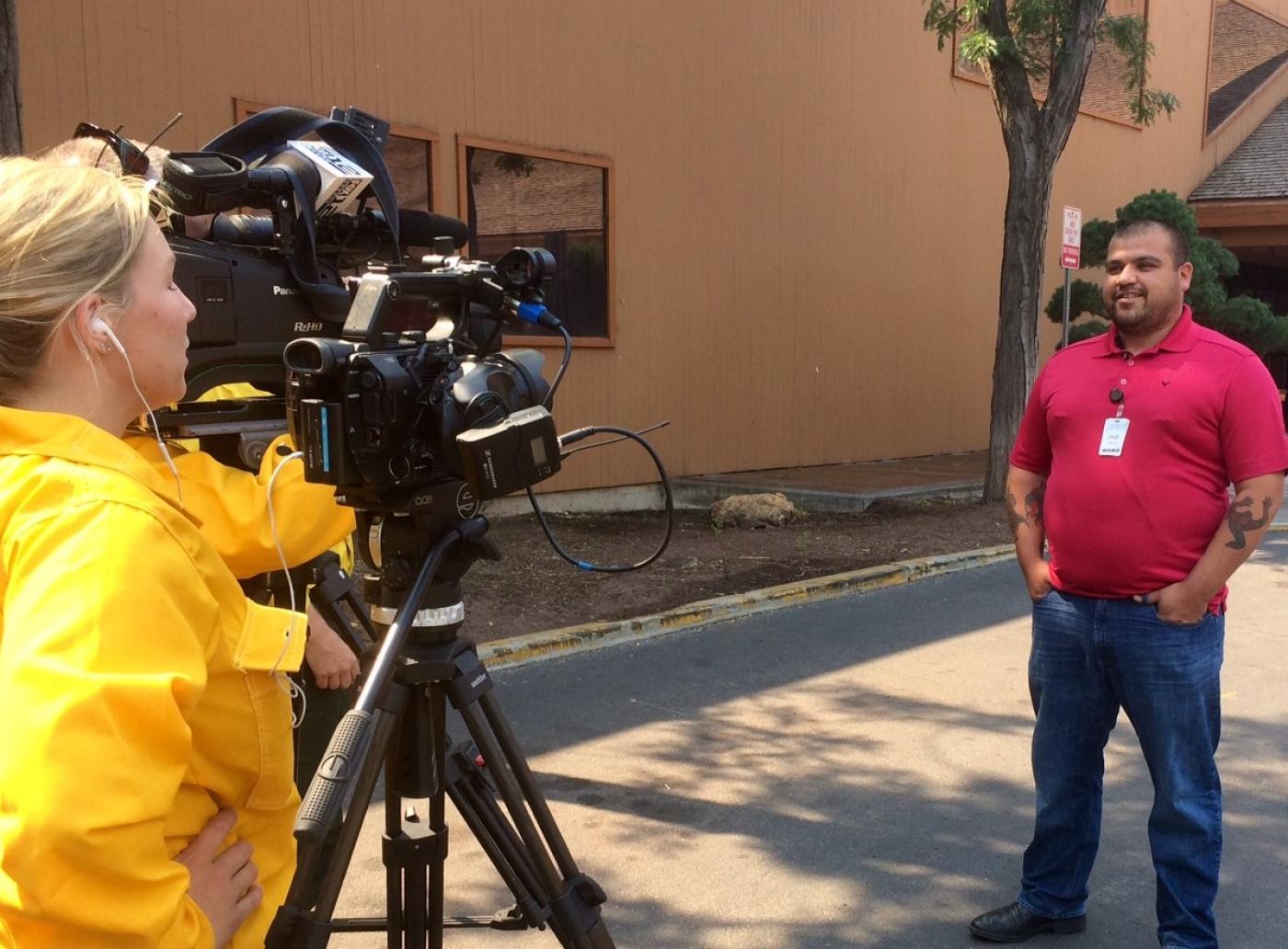What does a public information officer do?

A public information officer (PIO) formulates and releases information about emergency incidents such as wildland fire, search and rescue and natural disasters to the news media, local communities, incident personnel, the incident management team and other agencies and organizations. As a PIO progresses in their career, they may also manage other PIOs.
PIOs work within the Incident Command System (ICS), the system used to manage emergency and non-emergency events. They report to the incident commander, who in turn reports to the agencies or jurisdictions responsible for the incident.
For a comprehensive overview of ICS, see the independent study course Introduction to ICS (ICS-100).
Who is eligible to be a public information officer?
Anyone can be a PIO. While there are no formal qualifications, the position requires good interpersonal and writing skills.
Each PIO position level requires training and completion of position taskbooks.
What are the different qualifications and levels of expertise?
You begin at the trainee level as a public information officer, technician (PIOT). At this stage, you work towards completing the Type 3 public information officer (PIO3) taskbook.
Once you complete the PIO3 taskbook, with additional training you can become a public information officer complex (PIOC). As of January 2023, this is the most advanced PIO position.
PIO3 and PIOC positions serve in various capacities on an incident management team. For a visual representation of where PIOs are positioned within the command structure, visit the the National Wildfire Coordinating Group Fire Position Qualification Flow Chart (PMS 308) page.

What do I need to do to start the process? Why do I need training?
Following discussion of your interest with your supervisor, contact your local fire or emergency management officer. The management officer can initiate your taskbook.
PIOs who work fire and non-fire incidents are certified through the completion of requirements listed in the National Incident Management System (NIMS) Qualification System Guide. The requirements may seem challenging at first glance, but you will use the skills you develop on a daily basis.
Training
Training and qualifications are completed through four avenues:
- training courses, which provide specific background knowledge;
- position taskbooks, which contain tasks required to perform the job;
- job aids, to provide ready reference; and
- agency certification issued by the Bureau of Indian Affairs.
Some training is available online for free. Other courses are classroom-only, with options for in-person or virtual. For upcoming training opportunities, consult your fire management officer for information for local courses, or log into the Wildland Fire Learning Portal to view the nationwide schedule of classes.
Required classes and qualifications for the all PIO levels can be found in the National Wildfire Coordinating Group Catalog.
Information Officer Position Taskbooks
Your home unit must initiate the taskbook. To find the PIO taskbooks, search for the term “information” in the NWCG Catalog.
Physical Fitness Requirements
If your position requires visiting a fireline unescorted to take photos, you must pass a “light” fitness test of walking a mile in 16 minutes, without carrying any weight.
Otherwise, there are no physical fitness requirements.
The Next Step
You will receive an Incident Qualifications and Certification System (ICQS) card, also known as a “Red Card.” If you are a PIOT working towards opening a PIO3 taskbook, your Red Card will qualify you as a PIOT (public information officer, technician). If you have an open PIO3 taskbook, your Red Card will qualify you as a PIO3(t) (public information officer 3, trainee).
When any taskbook is completed, your home unit will finalize your certification. You will receive a Red Card that qualifies you as a PIO, which allows you to visit the fireline on incidents. You must also be registered in the Resource Ordering and Status System (ROSS). Check with your local unit protocol on how to be added to ROSS.
Reminders
Once you have supervisor approval, let your local dispatch office know when you are available locally, regionally, or nationally.
Regularly update your incident experience, training and taskbook records with your fire program management assistant or dispatch with the IQCS update form.
Public Information Officer Qualifications
You can work as a trainee as long as you have a Red Card, an initiated taskbook and an annual refresher. The training and taskbook must be completed to be fully qualified. Taskbooks expire three years from the date the first task in the taskbook is signed. To maintain currency, PIOs must have an assignment at least once every five years.
Visit the links to view position training and requirements:
- Public Information Officer, Technician (PIOT) - This position requires training. There is no taskbook associated with this position, but once you gain the adequate experience, you will be approved or recommended to open a PIO3 taskbook.
- Type 3 Public Information Officer (PIO3)
- Public Information Officer Complex (PIOC)

Emergency Management Institute
The Emergency Management Institute (EMI) PIO training program is designed to provide PIOs with the essential knowledge, skills, and abilities to deliver the right message to the right people at the right time. Learn more about the training courses FEMA provides for PIOs here.
Public information is vital to disaster operations and helps save lives and protect property. Public information entails the processes and systems that enable effective communications with various target audiences. The EMI training program provides PIOs with the opportunity to learn and practice the tasks of gathering, verifying, coordinating, and disseminating public information at all levels of government.
Themes woven throughout the series include the 95/5 concept, as well as an emphasis on whole-community strategic communication planning.
The 95/5 concept relates to non-emergency and emergency PIO activities: 95% of most PIOs' work takes place during non-emergency times, while 5% involves incident response or recovery. The activities a PIO chooses in non-emergency times has a significant impact on how successful he or she will be during emergency response and recovery. This training focuses on both parts of the equation.
The training courses listed below include those delivered at the state, local, Tribal, and territorial level, as well as higher level training managed by EMI’s subject matter-expert training teams. Click on a program for additional information.
EMI managed courses
- IS-29 – Public Information Officer Awareness - The Public Information Officer Awareness Course (IS0029) is designed to familiarize participants with the concepts underlying the PIO role. This course provides an introductory overview of the PIO function, which benefits both new PIOs and non-PIO executive-level professionals.
- G290 – Basic Public Information Officer - This two-day course considers the value of communication before, during and after an incident. It helps PIOs identify critical internal and external audiences.
- G291/E-L0387 – Joint Information System/Joint Information Center Planning for Tribal, State and Local PIOs - This one-day course outlines the communications needed for different incidents and defines the roles of the PIO within the incident command system. E/L 0387 is the course version EMI often offers on-campus just prior to the 0388 course for students who lack access to the training in their states.
- E/L0388 – Advanced Public Information Officer - The goals of this five-day course are to:
- provide participants with the knowledge and skills to establish, manage and work within a joint information system, through multimedia lectures and individual and group activities.
- provide participants the opportunity to apply advanced public information skills during a multi-day functional exercise (FE) designed to test the participants’ abilities to analyze, coordinate, process and create information in a fast-paced, realistic environment.
- encourage participants to evaluate their processes to help them generate new ideas, products, or ways of viewing challenges or situations through a tabletop exercise (TTX).
- encourage participants to improve their processes and ensure every action has a measurable relevance for each identified audience, including senior leadership.
- Master Public Information Officer Program: E0389, E0393, E0394 - The goals of this three-course series are to:
- prepare public information officers for an expanded role in delivering public information and warning using a strategic whole-community approach.
- reinforce the qualities needed to lead whole community public information/external affairs programs, provides relevant management theories and concepts, and uses case studies to enhance public information/external affairs skill sets. MPIOP participants work within a collaborative environment on projects and establishes a network of peers.
- allow MPIOP participants to contribute to the body of knowledge for emergency management related public information. This includes evaluation of leadership, group dynamics and functional best practices of joint information centers by monitoring student activity during advanced public information officer course offerings.
Contact Us
Boise, 83705


